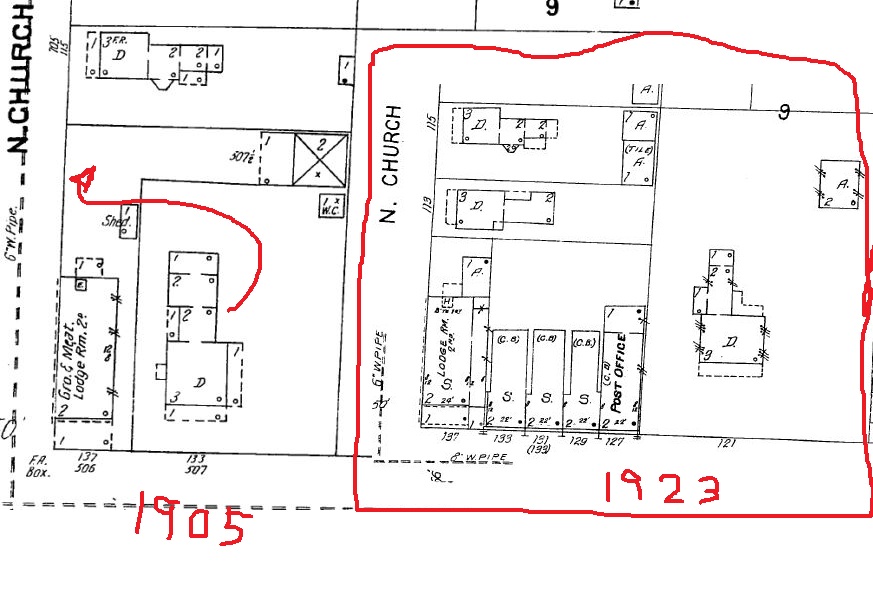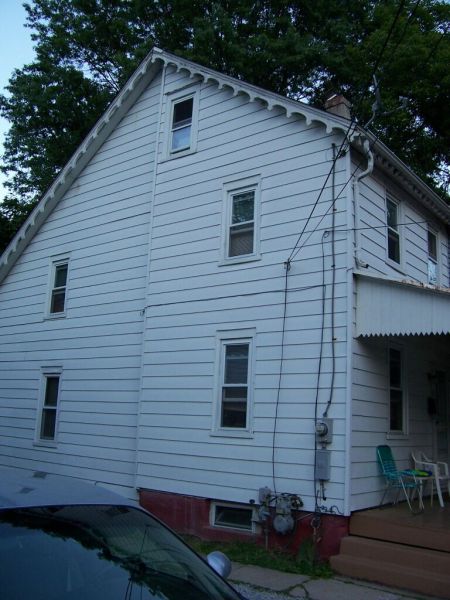 Sanborn map detail, 1896  Sanborn map detail, 1905  Sanborn map detail, 1923 |
 From Chronicle, First Baptist Church Anniversary |
You can download some of his books free in PDF format! Or you can buy them printed at pretty much no more than what it would cost you to do it. To save the books in PDF format- On the right on each downloadable book's webpage will be a download link. You must click it, then when the PDF file is viewable, go to the second button on the top of the Adobe PDF viewer and choose to "Save" the file.
This webpage is an advertisement for the books as well as "A Few More For Phil."
 Sanborn map detail, 1896  Sanborn map detail, 1905  Sanborn map detail, 1923 |
 From Chronicle, First Baptist Church Anniversary |

Also on the above images is the mansion nextdoor. From Percy Lovell's old column in the Moorestown Chronicle, a featured article discussed "Olde Time Schools and Such." (It wanders in the "and Such.") ... "Dr. A.M. Stackhouse, who for many years resided in the three-story brick house at 121 West Main Street, since torn down and now is the site of the Woolworth store."
Note the "Settle Press" in his yard. Below are some books he had printed at it.-
http://www.archive.org/details/kingshighwaypenn00stac
http://www.archive.org/details/retrospectofcolo00stack
http://www.archive.org/details/maladiesremedies00stac
|
The drinking and bar fights at the Stanwick Hotel and the West End Hotel probably kept the Moorestown Police busy on more than several occasions! There were some graphic accounts.
In the NJ Mirror, July 6, 1892, Moorestown, drunks 4th of July
On the "other side" of Stanwick, from the NJ Mirror, June 14, 1894, is a mission- |
 From the NJ Mirror, July 12, 1893 |
Moorestown's going "dry" in the 1900s was a result of various groups during the late 1800s.
From the NJ Mirror, February 15, 1893-
Moorestown- Rev. W.T.S. Lumbar continued his subject of saloons, last Sunday at the Baptist Church. Mr. Lumbar is a very plain spoken man and says just what he thinks and although his arguments are undoubtly right, he hasn't got as many friends as he had before he delivered the last few sermons on dancing, card playing, theatres and saloons.
|
In the 1890s, as a result of all the industrial endeavors, you had an apparent very wealthy class as well as at the other end of the spectrum a poorer working class. The Stanwick Carpet Factory had a few ups and downs before it went out of business. Another business was a canning factory on Schooley Street. There was a lot of workers in companies selling ice, coal, etc.... Of course many workers might have come by train etc... to work in town.
The NJ Mirror, June 6, 1894-
And then we have things like this, from the NJ Mirror, June 21, 1893- |
 From the NJ Mirror, December 6, 1893 |
|
Thomas Gill was a builder, and don't ask for too much more information because its a family that repeats the name Thomas and I haven't researched him. A house on Mill Street, which btw is mentioned in James C. Purdy's book, on the very last page, being 221 and 223 Mill Street was an old farmhouse dating possibly to the 1700s which was moved to and altered to be what it is today. 
|

The owner of 223 Mill let me tour it and showed me some of the wooden dowel peg joints. In the photo at left on the paint on a door you can see an old wrought iron latch mark. In the photo above you can see how a back addition was added to a narrow style house. |
|
I would think Thomas Gill, as he owned them, built the two houses on Second Street at each corner of Mill Street. He owned the whole area of Mill Street north of Second Street in the late 1800s.  From J.D. Scott's 1876 Atlas of Burlington County |

|
Thomas Gill also owned the house behind the "Corner Store," as we used to call it, on Third Street. About 1968 or 1969 there was a fire at the house. Destroyed in the fire were thousands and thousands of dollars worth of puppets. The lady who lived there was a professional puppeteer. Us kids then referred to the house as the "Puppet House." Today this house is painted a beautiful yellow color.
Remember the Moorestown Fair, put on by the PTA, when it was at the old High School? There was a "train" (a wooden car with seats I believe pulled by a tractor) which drove around the nearby streets and kids would board it to go to the fair.
There was, as I remember, donkey cart rides. (maybe one year a variation of the pony cart rides) I loved this and even though I was very allergic to horses I could ride in the donkey cart! There was a haunted house in the old Science Building which always had such a huge line that I never bothered. Upstairs via fire escapes was a room full of items for sale. (I believe used clothes on long tables) Adults and kids enjoyed lemons with candy straws which made the lemons sweet. There were a few kiddie rides as well.
When the Moorestown Fair went to be at the new High School, the pony cart rides were replaced by mini bikes pulling carts and called Chariot rides. Even though I was approaching about 10 maybe, this was too scary.

Anybody like the old way the Moorestown Mall was? I did. It had a Path Mark where the food court is. It had a Woolworth's five and ten. It had a beautiful high ceiling with columns that widened at the top, palm trees, a monkey cage, bird cages, a duck pond, and a lot of artistic fountains. I would go as far as to say, "They wrecked it with rennovations!"

I loved the Moorestown Rec Center that was/is in the old gymnasium of the Moorestown High School which was razed for the new library. It had basketball on the first floor and on the third floor, where the old cafeteria was, they had bumper pool, pool, ping pong, etc..., and a juke box.
Before this was a previous youth center, but It reminds me of the "Moorestown Hippies." The hippies would hang out in front of the Moorestown Theatre or be sitting down all along that mound of stones that went in front of the covered walkway at the First Baptist Church. My Uncle who was in the Moorestown Jaycees said that the Moorestown Police came to the Jaycees asking what could be done about all the kids wandering around Main Street, so the First Baptist Church said it was ok for them to use their parking lot.

Well I just wanted to advertise Philip J. Flander's books, and throw in some more tidbits of history for people to enjoy thinking about. Maybe I'll add a few more later on.
-den